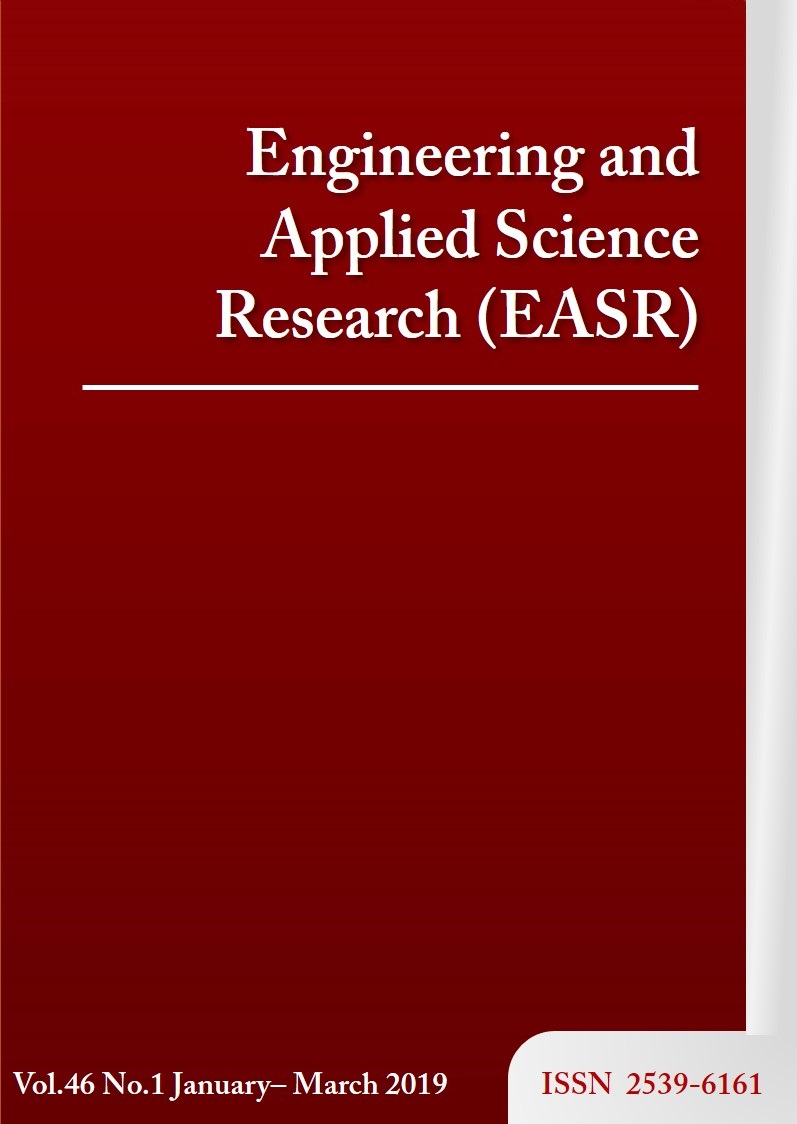Forecasting oil palm and crude palm oil data in Thailand using exponential time-series methods
Main Article Content
Abstract
In this paper, several exponential time-series methods are applied to forecast oil palm prices, crude palm oil prices, and crude palm oil production in Thailand from January to March 2018. The selected methods include Double Exponential Smoothing (DES), the Multiplicative Holt-Winters (MHW), the Additive Holt-Winters (AHW), the Improved Additive Holt-Winters (IAHW), and the Extended Additive Holt-Winters (EAHW) methods. Input data from January 2005 to December 2017 (thirteen years) were collected from the databases of the Office of Agricultural Economics and the Department of Internal Trade. Here, the novelty of our work is twofold. First, three closely related input data types are forecasted and analyzed simultaneously. Second, the well-known time-series forecasting methods (i.e. the DES, the MHW, and the AHW methods) and the efficient methods recently proposed in the literature (i.e. the IAHW and the EAHW methods) are implemented and tested. Therefore, the best forecast results determined by optimal methods are revealed. Our study demonstrates that the DES and the EAHW methods provide the smallest error (measured by Mean Absolute Percentage Error, MAPE) in forecasting oil palm and crude palm oil prices. For crude palm oil production, the IAHW and the EAHW yield better performance. The results also show the trends of the average monthly and yearly data and indicate that during January to March 2018, crude palm oil production in Thai markets should increase and prices will likely be stable. We believe that our research methodology and results can be useful for planning and setting strategy for Thai agriculturists and the government.
Article Details
This work is licensed under a Creative Commons Attribution-NonCommercial-NoDerivatives 4.0 International License.
References
[2] Mungmee T, Buaklom P, Pungprasert P, Sinlapaprechar P, Suksa-ard C, Raweewan M. A framework study of factors effecting crude palm oil price behavior in Thailand. 4th International Conference on Engineering, Project, and Production Management; 2013 Oct 23-25; Bangkok, Thailand. p. 647-53.
[3] The Department of Internal Trade, Ministry of Commerce [Internet]. [cited 2018 Feb]. Available from: http://www.dit.go.th/.
[4] Gelper S, Fried R, Croux C. Robust forecasting with exponential and holt-winters smoothing. J Forecast. 2010;29:285-300.
[5] Brown RG. Exponential smoothing for predicting demand. The 10th National Meeting of the Operations Research Society of America; 1956 Nov 14-15; San Francisco, USA. San Francisco: Little; 1956.
[6] Hunter JH. The exponentially weighted moving average. J Qual Tech. 1986;18(4):203-10.
[7] Winters P. Forecasting sales by exponentially weighted moving averages. Manag Sci. 1960;6(3):324-42.
[8] Gardner ES. Exponential smoothing: the state of the art. J Forecast. 1985;4:1-28.
[9] Montgomery DC, Jennings CL, Kulahci M. Introduction to time series analysis and forecasting. USA: John Wiley and Sons; 2008.
[10] Kalekar PS. Time series forecasting using holt-winters exponential smoothing. Kanwal Rekhi School of Information Technology. 2004:1-13.
[11] Ramos P, Santos N, Rebelo R. Performance of state space and ARIMA models for consumer retail sales forecasting. Robot Comput Integrated Manuf. 2015;34:151-63.
[12] Siregar B, Butar-Butar IA, Rahmat RF, Andayani U, Fahmi F. Comparison of exponential smoothing methods in forecasting palm oil real production. IOP Conf. Series: J Phys. 2017;801:1-9.
[13] Wan Ahmad WKA, Ahmad S. Arima model and exponential smoothing method: a comparison. API Conference Proceedings. 2013;1522:1312-21.
[14] Tularam GA, Saeed T. Oil-price forecasting based on various univariate time-series models. Am J Oper Res. 2016;6:226-35.
[15] Tularam GA, Saeed T. The use of exponential smoothing (es), holts and winter (hw) and Arima models in oil price analysis. Int J Math Game Theor Algebra. 2016;25(1):13-22.
[16] Tratar LF. Forecasting method for noisy demand. Int J Prod Econ. 2015;161:64-73.
[17] Tratar LF, Mojskerc B, Toman A. Demand forecasting with four-parameter exponential smoothing. Int J Prod Econ. 2016;181:162-73.
[18] Tratar LF, Srmcnik E. The comparison of holt-winters method and multiple regression methods: a case study. Energy. 2016;109:266-76.
[19] Office of Agricultural Economics, Ministry of Agriculture and Cooperatives [Internet]. [cited 2018 Feb]. Available from: http://www.oae.go.th/oaenew/ OAE/.
[20] Holt CC. Forecasting seasonals and trends by exponentially weighted moving averages. Int J Forecast. 2004;20(1):5-10.
[21] Dhakre DS, Sarkar KA, Manna S. Forecasting price of brinjal by holt winters method in west bengal using MS excel. Int J Bio-res Env Agril Sci. 2016;2(1):232-5.
[22] Booranawong T, Booranawong A. Simple and double exponential smoothing methods with designed input data for forecasting a seasonal time series: in an application for lime prices in Thailand. Suranaree J Sci Technol. 2017;24(3):301-10.
[23] Booranawong T, Booranawong A. An exponentially weighted moving average method with designed input data assignments for forecasting lime prices in Thailand. Jurnal Teknologi. 2017;79(6): 53-60.
[24] Chatfield C. Time-series forecasting. New York: Chapman & Hall; 2001.
[25] Gentry TW, Wiliamowski BM, Weatherford LR. A comparison of traditional forecasting techniques and neural networks. In: Dagli CH, Akay M, Chen CLP, editors. Intelligent engineering systems through artificial neural networks, Vol. 5. New York: American Society of Mechanical Engineers; 1995, p. 765-70.
[26] Alon I, Qi M, Sadowski RJ. Forecasting aggregate retail sales: a comparison of artificial neural networks and traditional methods. J Retailing Consum Serv. 2001;8(3):147-56.
[27] Ravindran A, Warsing DP. Supply chain engineering: models and applications. New York: CRC Press; 2013.



